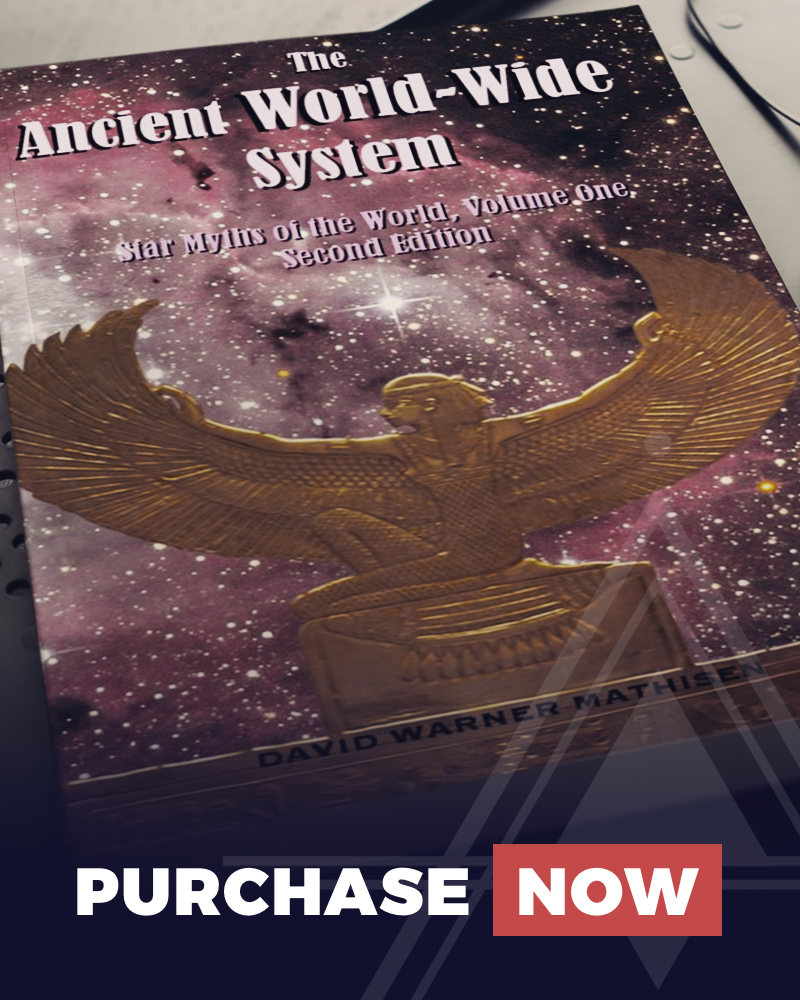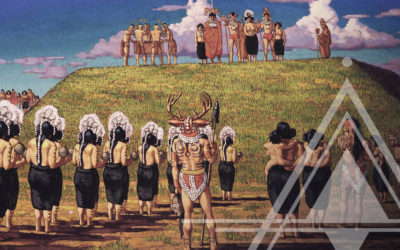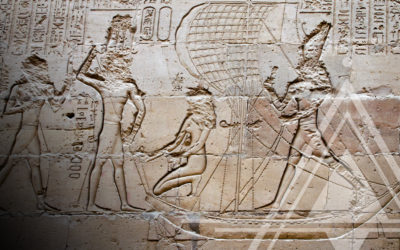David W. Mathisen
Myths and our Lost Origins
Aug 18
David Mathisen
Tags
Those authors rightly point out that several of the individual pieces of evidence from antiquity would in and of themselves be sufficient to reveal that the standard academic paradigm of human history is untenable – and taken in their entirety, when adding all the individual examples found literally around the globe, the weight of the evidence crushes that conventional paradigm completely.
For example, the fact that the Great Pyramid of Giza (whose construction itself is extremely difficult to explain) has dimensions which indicate remarkably precise understanding of the size of our spherical planet poses significant problems for the standard historical narrative on a number of fronts.
As Graham Hancock and Robert Bauval point out in their 1996 book Keeper of Genesis: A Quest for the Hidden Legacy of Mankind, the perimeter of the base of the Great Pyramid (which they cite using 1996 data as 3024.16 feet and which a 1925 survey found to be 3024.154 feet) can be multiplied by a factor of 43,200 in order to yield the equatorial circumference of the earth within 0.75% of the correct dimensions as measured by the best modern instruments.1 They demonstrate that the height of the Great Pyramid (based on the apex height where the lines of the sides would all meet) can similarly be multiplied by the same factor of 43,200 in order to yield the polar radius of our planet, an “underestimate by just 11 miles of the true figure for the polar radius of the earth (3949 miles) worked out by the best modern methods.”2
The dimensions of the Great Pyramid thus demonstrate an astonishing level of knowledge regarding the size and shape of our spherical planet, coupled with an ability to express that precise level of understanding in a stone monument of megalithic proportions (including the massive granite beams incorporated into the so-called “relieving chamber” inside the Great Pyramid, each of which is approximately 26 feet in length and weighs up to 50 tons).
This knowledge, demonstrated beyond dispute by the physical dimensions of the Great Pyramid itself, places significant strain on the defenders of the conventional paradigm – but the “multiple” selected by these ancient builders to express the ratio between the size of the pyramid and the size of our planet adds additional stress. The number 432 is known as a “precessional number,” relating to the barely-perceptible motion of precession, which is generally understood to be caused by a gyroscopic turning of the axis of our planet such that the poles trace out a circular motion over the course of tens of thousands of years.
Some researchers, most notably Walter Cruttenden, have suggested that the phenomenon of precession might be caused by a binary relationship between our sun and another star, as opposed to the precessing of our own planet’s axis (see his arguments in Walter’s 2005 book, Lost Star of Myth and Time, and his presentation of additional data periodically at the Conference on Precession and Ancient Knowledge, the eleventh iteration of which will be held this coming October 4th through 6th, 2019, in Newport Beach, California). Whatever its cause, however, the phenomenon of precession is undeniable and is readily acknowledged and widely studied by astronomers – and the use of a multiple of 432 in the ratio between the Great Pyramid and the size of the earth indicates a level of understanding of precession which again confounds the conventional paradigm.
The phenomenon of precession (whatever its cause) creates a nearly imperceptible “delay” in the background of stars, such that the stars in the region of the ecliptic and the celestial equator will be a mere one degree of arc behind their anticipated position on any given day in our orbital journey around the sun after 71.6 years. As we go around the sun each year, the stars we see change throughout the seasons, because we look out into a different region of space as we make a full orbit around our central star, the sun. However, when we return to the same precise point on our orbit, we should see the stars in the same place where we saw them on that exact point in the orbit a year before, if we are measuring them at precisely the same time from precisely the same vantage point.
Many of the ancient stone monuments around the world facilitate just this type of observation. For example, the stone chamber in Upton, Massachusetts has a passageway which allows an observer inside a six-degree-wide field of view which looks out across a lake to a ridgeline beyond known as Pratt Hill – and as James W. Mavor and Byron E. Dix demonstrate in their 1989 book Manitou: The Sacred Landscape of New England’s Native Civilization, there are mounds upon Pratt Hill which precisely frame the heliacal setting of the stars of the Pleiades in mid-April during the period from AD 700 to AD 750, admirably demonstrating the way in which alignments of stones, mounds, and passages were used as a kind of “rifle sight” to enable observers to note the exact location of specific stars on specific points of our planet’s orbit.3 Many other examples can be found around the globe.
However, the motion of precession will gradually “delay” the position of the stars on the anticipated day each year, such that after 71.6 years a star will be “behind” by a single degree of spherical arc from its measured position on the same day 71.6 years before. The subtlety of this delay means that it would take many decades of very precise observation in order to even detect. One degree of arc is approximately the width of your little finger held out at arm’s distance against the sky – and note that it takes nearly 72 years to delay a star by that tiny amount. This very subtle rate of delay suggests that it would take many lifetimes of precise measurement and accurate recording and transmission of the results before precession could even be noticed (since very few observers could be expected to keep their own records for more than seventy years in a row, and even if someone did, the delay would only be one degree after seventy-two years).
For this reason, conventional academia generally asserts that precession was not measured with any degree of accuracy until the time of Hipparchus (thought to have lived from around 190 BC to 120 BC), who suggested that one degree every 100 years was the “lower bound” of the rate (it could be faster than one degree in 100, he realized, but he wasn’t able to say exactly how much faster). Later, his intellectual and astronomical heir Ptolemy (thought to have lived from around AD 100 to AD 170) was able to determine the correct rate of precession as delaying the background of stars by one degree every 72 years.
This delay of a single degree every 71.6 years will, after thousands of years, cause the background of stars to be delayed by such an amount that the delay will cause an entirely different zodiac constellation to be in the expected place on a specific day on our planet’s orbit, such that Taurus will be replaced by Aries, and then eventually Aries by Pisces, and Pisces by Aquarius, and so on. If we divide the full circle of the zodiac into twelve sections, each section will occupy one-twelfth of the full 360 degrees, or 30 degrees per zodiac section. Using the precessional constant of 72 and multiplying that times 30 degrees tells us that after approximately 2,160 years, the delaying motion of precession will delay the background of stars so much that on any specific point on our orbit around the sun (such as the four significant recognizable points of spring equinox, summer solstice, fall equinox, and winter solstice) the expected zodiac constellation will be delayed and the preceding constellation will be in its place on the anticipated day.
Thus, 216 becomes an important “precessional number” – and variations of 216 (such as 108 and 432, representing half of 216 and the double of 216) are found in the dimensions of ancient monuments around the world, including in the above-noted relationship between the dimensions of the Great Pyramid and the dimensions of our planet (related by a factor of 43,200 which is a variant of the important precessional number of 432).
In other words, not only does the Great Pyramid by its very measurements put extreme pressure on the conventional paradigm by silently attesting to an extremely ancient and extremely precise understanding of the size and shape of our spherical earth, but it does so through the incorporation of a precessional number – despite the fact that the conventional narrative of ancient history does not admit the ability to measure the subtle phenomenon so precisely with any degree of accuracy until the time of Hipparchus (whose estimates were not good enough to arrive at the number 72), thousands of years after the Great Pyramid was built.
The engineering ability to construct the Great Pyramid itself puts some strain on the conventional narrative of ancient human history: the fact that this massive monument also indicates a sophisticated understanding of the size and shape of our spherical planet, as well as the difficult-to-detect phenomenon of precession (whether caused by a slow gyroscopic circling of our planet’s rotational axis, or by a binary relationship between our sun and another star) should by itself be enough to show that the standard narrative being presented by academia is flawed. And that is just one aspect of one ancient monument on our planet: this example could be multiplied by the hundreds using other archaeological sites from other cultures around the globe.
In 2016 I wrote a blog post in which I introduced the metaphor of the “bad mechanic” who is trying to put together a complex engine but keeps coming up with a bunch of pesky “extra parts” at the end of the job, indicating that the engine has not been put together correctly: see “The great world-wide archaic framework (and the ‘bad mechanics’)” from September 20, 2016. Evidence which does not fit into the conventional paradigm, in this metaphor, is like the “extra pieces” left over at the end of putting together the engine. Even one extra piece left over at the end indicates that the “paradigm” used to put together the engine is incorrect – and the more pieces which don’t fit, the more we can be sure that the assembly job has not been done properly. On the other hand, when someone who actually knows how to put it together comes along with the correct understanding of how to assemble the engine, taking apart the incorrect attempt and putting it back together using a different “big picture” of how it all fits together, then we would expect all the “extra pieces” to fit into place.

The amount of evidence presented by the archaeological remains around the world would by themselves be enough to indicate that the conventional “reconstruction” of humanity’s ancient past, like the engine reconstruction that leaves out dozens of “extra parts,” is completely non-functional – but there is yet another category of evidence in addition to all the physical and archaeological evidence which again is sufficient all by itself to overturn the conventional paradigm, and which taken in conjunction with the other evidence demonstrates beyond all doubt that the academic position is utterly hopeless and will eventually need to be abandoned (and the sooner the better). That additional category of evidence is mythological – found in the ancient scriptures, myths, and sacred stories preserved by virtually every culture on our planet.
As Professors Hertha von Dechend and Giorgio de Santillana outline in their seminal 1969 text Hamlet’s Mill: An essay on myth and the frame of time, the world’s ancient myth shows unmistakable signs of being part of a vast ancient system, the complexity and sophistication of which has been completely ignored by modern academia. In one famous and evocative passage, they write:
I ween, in Valhall’s walls;
Eight hundred fighters through one door fare
When to war with the Wolf they go.
This incorporation into the Norse myths of Scandinavia and Iceland in far northern Europe of the same precessional number 432 that we saw operating in the dimensions of the Great Pyramid at Giza and its relationship to the size of our planet is staggering – and there are many other myths from around the world which also incorporate precessional numbers in much the same manner. We can begin to sense just how troubling the added evidence in myth will be for the conventional paradigm of human history, which has no way of explaining clear evidence of some ancient system, operating on a vast scale spanning cultures in many different parts of the globe.
It is noteworthy that this precessional number is incorporated by the Norse poem into the description of one aspect of the cataclysmic day of Ragnarok, because as the authors of Hamlet’s Mill also point out, the great “end of the world” myths (of which Ragnarok is one example, along with others found in myths worldwide) can be shown to be related to the great celestial phenomenon of precession described above, by which the delay of the background stars will, after approximately 2,160 years, replace the four zodiac constellations in which the sun rises on the significant annual station-markers of the solstices and equinoxes with a new set of four zodiac constellations – ushering in a new “age” and (metaphorically) a “new heavens and a new earth.”6
Thus, it appears that cultures around the world (and not just the designers of the Great Pyramid, whoever they were) were the inheritors of sophisticated ancient knowledge which is difficult if not impossible to explain within the existing academic framework of history.
But the pressure from the evidence in ancient myth becomes more irresistible still, because (although the authors of Hamlet’s Mill did not perceive most of them, due in part I would argue to the fact that they did not avail themselves of the excellent system of outlining the constellations proposed by the famous author H. A. Rey in 1952 with the publication of The Stars: A New Way to See Them), the parallels between the world’s ancient myths and the stars and heavenly cycles are so abundant and overwhelming that they simply cannot fit into the conventional paradigm and demonstrate (like so many “extra parts” left over after constructing the engine) that the entire academic narrative is completely untenable.
After my first encounter with Hamlet’s Mill, and its suggestion of a deep connection between the myths and the stars (two subjects with which I have been fascinated since I was a child), I began to pursue this connection with an almost-obsessive focus. Over the past ten years, I’ve written nine books totaling over 5,000 pages as well as nearly 1,200 blog posts detailing this evidence – and I will readily admit that I’ve only barely scratched the surface of evidence that is available in the world’s ancient myths, scriptures and sacred stories.
Among these books are the four volumes in my Star Myths of the World series. My most-recent book is a completely revised and expanded version of Volume One of that series – the new edition of which is entitled The Ancient World-Wide System: Star Myths of the World, Volume One. The other volumes to date include Star Myths of the World, Volume Two (Myths of Ancient Greece), Star Myths of the World, Volume Three (Star Myths of the Bible), and Star Myths of the World, Volume Four (Norse Mythology).
I went back and revised and expanded the first volume of the series into The Ancient World-Wide System (which itself totals 912 pages and contains over three hundred illustrations, diagrams and star charts) because by the time I had written Volumes Two, Three, and Four (as well as some other books in between, including Astrotheology for Life) I had learned so much more about the myths and their connection to the stars that I wanted to update Volume One.
Unlike the subsequent volumes, The Ancient World-Wide System explores myths from many different cultures (whereas the subsequent volumes focus more narrowly on the myths within one culture or tradition). Myths and scriptures examined in The Ancient World-Wide System include those from Australia, Africa, the Pacific, the Americas (including myths of the Maya preserved in the Popol Vuh), and from ancient Mesopotamia, ancient Egypt, ancient India, ancient China and Japan. Abundant evidence demonstrates that these myths from cultures spread across virtually every inhabited continent and island of our planet are using a common system of celestial metaphor, and one unlikely to have sprung up independently among different cultures (because some of the details and correspondences across cultures are extremely obscure or arcane).
Such evidence, of course, is extremely difficult to reconcile with the standard narrative of ancient human history. However, when we allow for the possibility of the existence of an extremely ancient “predecessor culture” or “predecessor civilization” (now long forgotten), within which this amazing system may have originated and from which the ancient myths of cultures worldwide may be descended, then all of this evidence fits into place – along with the archaeological evidence we find worldwide as well.
Here are a few visual examples to illustrate this world-wide connection, many of which are discussed in much greater detail in The Ancient World-Wide System. The outline of the stars of the constellation we call Hercules is not exactly easy to trace out – it actually took me a long time before I was comfortable finding them in the sky. We would not necessarily expect multiple cultures around the world to independently envision these stars as being connected in the same way – and yet this constellation can be shown to have been envisioned in very much the same way in cultures around the globe, and to be associated with the same characteristics in myth-systems worldwide.
Below is a diagram showing the outline of Hercules as suggested by H. A. Rey in his vitally-important 1952 book The Stars: A New Way to See Them.
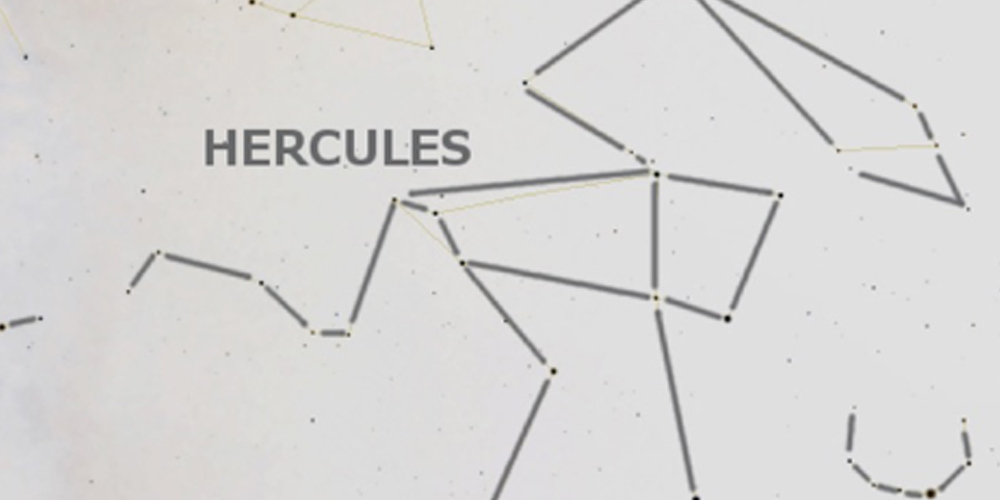
- A very square-shaped head
- A large weapon brandished overhead
- A “lunging-forward” posture, with both knees bent as if doing a “lunge” exercise with a barbell over the shoulders
- A downward-reaching arm (the arm not brandishing a weapon overhead)
Now look at ancient depictions of the hero Heracles, below. The general consensus among most analysts is that the constellation was named for the hero – but I would argue that in fact the myths are based on the stars, and that the hero Heracles (as well as many other mythical figures who are also based on this same constellation) takes his characteristics from the figure in the heavens, and not the other way around:
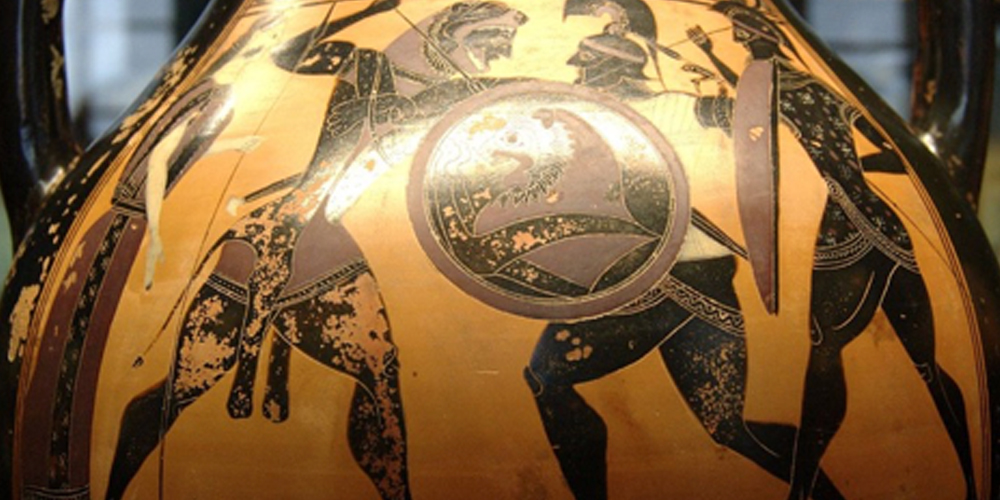
Heracles in the ancient artwork is brandishing a weapon overhead with the same arm that is raised and brandishing a weapon in the constellation in the heavens. His legs are in a lunging-forward posture that is reminiscent of the outline of the constellation, although the effect is more pronounced in other ancient artwork.
Most revealing is the fact that the forward-reaching arm of the hero (the one not holding a weapon overhead) can be seen to be grasping the arc-shaped crest of his opponent: this detail is present in many ancient depictions of the hero Heracles, and is inspired (I argue) from the fact that the constellation Hercules in the sky is positioned directly adjacent to the constellation Corona Borealis (also called the “Northern Crown”), and Hercules can indeed be envisioned as reaching out and “grasping” the arc of the Northern Crown, as illustrated below:
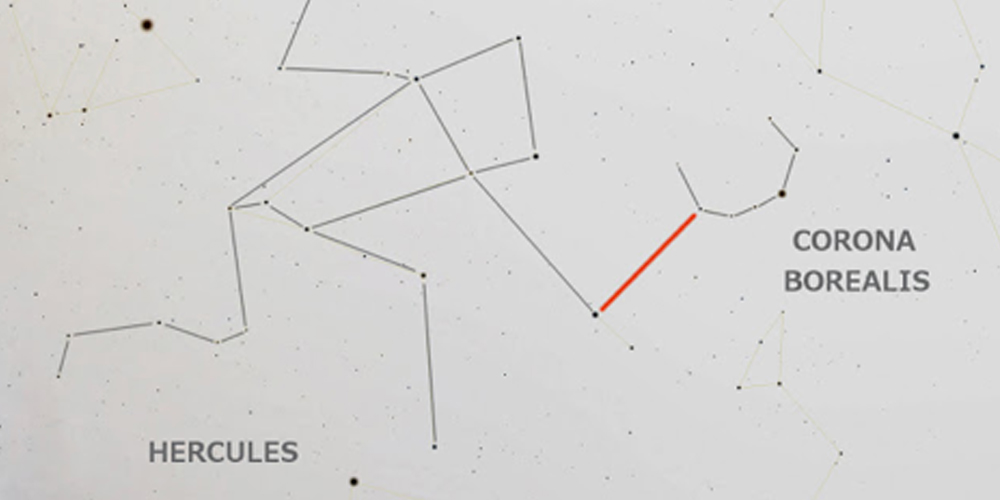
In this famous scene from the Old Testament, it can be demonstrated that the swordsman holding the baby corresponds to the very same constellation Hercules – and that this time, the arcing figure of Corona Borealis corresponds to the baby. Indeed, paintings down through the centuries of this famous Biblical scene invariably portray the swordsman brandishing his weapon over his shoulder in a posture reminiscent of the constellation Hercules, while grasping the heel of an infant who is “arching” vigorously in a manner evocative of the outline of the constellation Corona Borealis, immediately in front of Hercules:
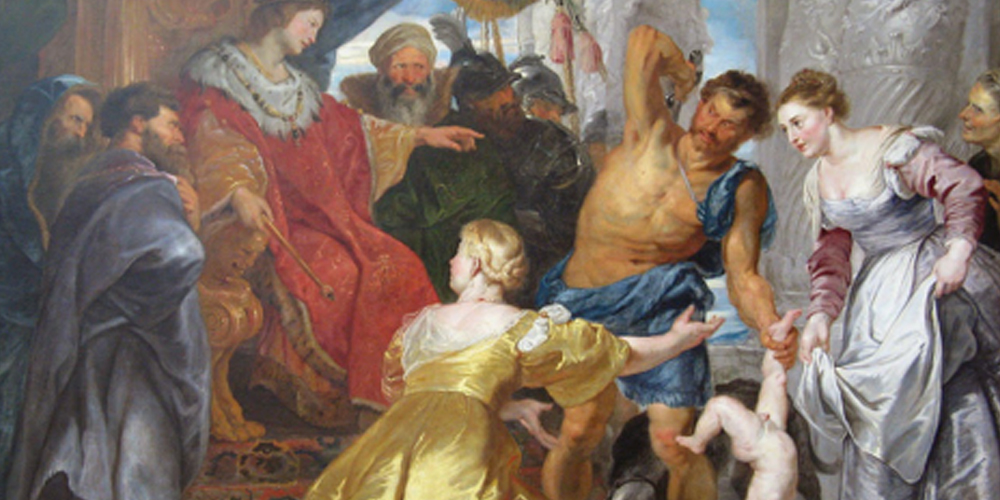
The reason this particular New Testament story is so important is that there is another myth from the cultures of the Pacific in which the baby Maui is cast into the sea-foam by his parents when he is born, and he is pulled out of the water and rescued by his formidable grandfather, Tama-nui-ki-te-Rangi, who hangs the baby up in the rafters to dry out and warm up.7 This episode from the myths of the Pacific can be shown to be based on the very same proximity of the constellations Hercules and Corona Borealis at work in the story of the Judgment of Solomon, from the complete other side of the globe.
We would have to admit that (even setting aside the fact that envisioning the outline of the constellation Hercules is not easy, and not likely to be hit upon independently by multiple different cultures) seeing the Northern Crown as an “arching baby” is a very obscure and unlikely connection, and one we would not expect to arise in different cultures around the globe without any connection to one another – and yet this is exactly what we do find. The conventional paradigm of human history would have a very difficult time explaining such evidence – but if we admit the possibility of an even more ancient predecessor culture predating all of the known cultures by thousands of years, then these parallels found around the world become completely understandable.
Ancient artwork containing clear references to the constellation Hercules can be found in cultures around the globe. Below is another image from ancient Greece, this one from artwork depicting the great god Zeus, battling the monster Typhon:
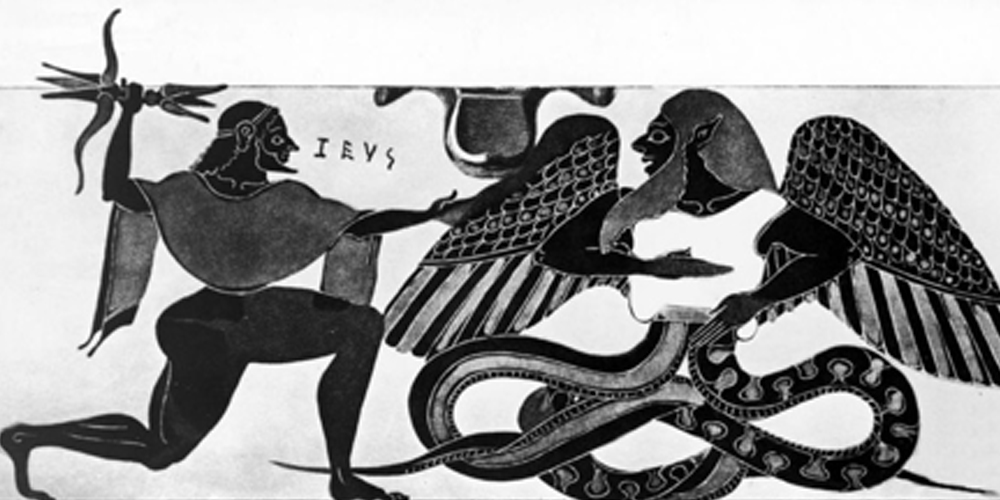
Indeed, I would argue that the correspondences between the figure of Zeus shown above and the constellation Hercules in the heavens are undeniable:
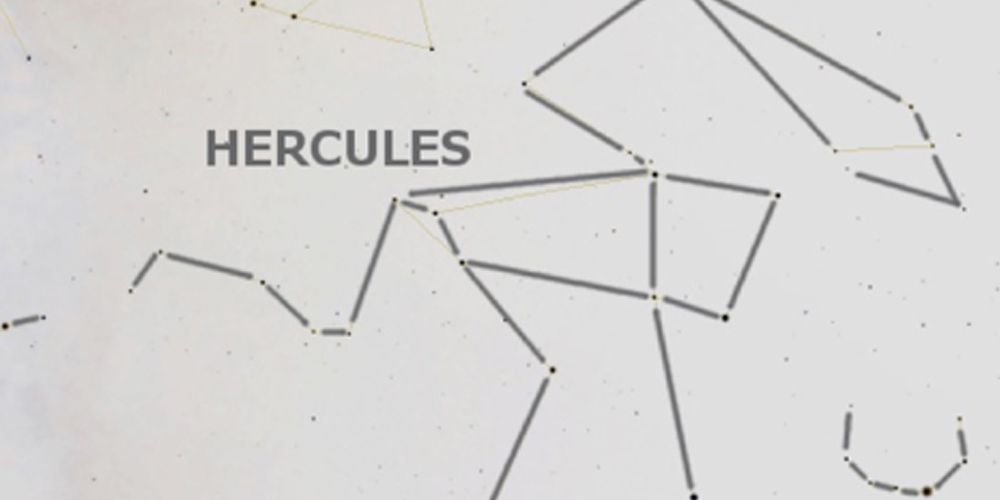

There is simply no way for the conventional paradigm of humanity’s ancient history to reconcile all this evidence – and the above examples are just a tiny sampling of the evidence available in the world’s ancient mythology (and the surviving ancient of figures inspired by the world’s ancient myths). Along with all the other evidence from around the world which has been chronicled by other researchers, the fact that the world’s ancient myths can be shown to be built upon a common system of celestial metaphor puts unsustainable pressure on the current prevailing academic paradigm of human history. The current paradigm will eventually have to admit its unsustainable position and capitulate: the evidence pointing to the existence of an advanced ancient culture in humanity’s ancient past (far older than any of the most-ancient civilizations presently admitted by the conventional academics) is simply too great.
The reason this mythical evidence points to a culture even more ancient than those of ancient Mesopotamia or ancient Egypt or ancient India or ancient China is that this system can already be shown to be in place, seemingly fully mature, in even the oldest surviving texts and artwork from any of those civilizations. It is already in place in the ancient Mesopotamian tablets, including those which relate the famous Gilgamesh cycle, some of the oldest extant texts known to history. The characters and events in the Gilgamesh epic can be shown to be built on the very same system of celestial metaphor described above – indeed, below is a sketch I made of an ancient Sumerian cylinder-seal dated to the early second millenium BC (between 2000 BC and 1800 BC), showing Gilgamesh and Enkidu in their battle with Humbaba (or Huwawa):

Below is another sculpture from ancient Mesopotamia, discovered in the ruins of the ancient city of Nineveh by an archeological expedition in the first quarter of the nineteenth century, and thought to depict the god Marduk in pursuit of some kind of supernatural foe:
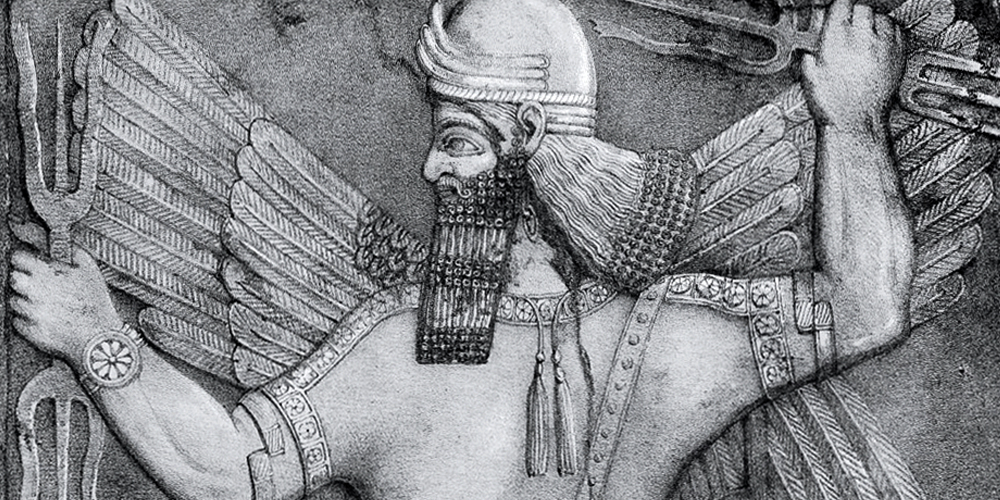
These correspondences are simply undeniable. The guardians of the conventional paradigm will eventually have to admit that they simply cannot exclude the evidence forever, and will have to change their paradigm. Other evidence pointing to the existence of a long-forgotten advanced civilization is becoming more and more difficult to ignore. The discovery of the massive complex of Gobekli Tepe, in modern-day Turkey, a site which was buried no later than 8000 BC and which may have been created by 10,500 BC or perhaps even earlier, points to the existence of cultures of extreme antiquity (more than 5000 years prior to the beginning of dynastic Egypt) which do not fit within the conventional academic paradigm at all.
Nevertheless, old paradigms do not change easily. The defenders of the flawed paradigm are like the “bad mechanics” who have reassembled the engine incorrectly, but will not let anyone touch it. The old paradigm explains some of the evidence, even though there is a growing pile of “extra parts” which it cannot explain. It is like an engine that is firing on only three cylinders out of eight, but is still moving the car forward. The academics inside the car are terrified of anyone taking the engine apart: “Don’t touch that engine! At least it’s firing on three cylinders!”
The evidence from myth is absolutely overwhelming to the defenders of the old paradigm – but they are not likely to disassemble their engine on their own. Therefore, it is up to the people to pursue the evidence that the academics and the keepers of the old narrative refuse to see. I would recommend that everyone who is interested in these matters go to their local libraries and recommend The Ancient World-Wide System be added to the collection. If you are in college, or if you know someone who is in college, request that the university library purchase The Ancient World-Wide System (as well as the other volumes in the Star Myths of the World series), so that the younger generation can have access to this evidence.
And, if you or someone you know is a professor in a field related to the study of ancient history (and especially the study of ancient myth), I would recommend considering this evidence in light of the other evidence from around the world which demonstrates that our current narrative of ancient human history is flawed beyond repair and must be replaced.
References
- Bauval, Robert and Graham Hancock. Keeper of Genesis: A Quest for the Hidden Legacy of Mankind. London: Heinemann, 1996.
- De Santillana, Giorgio and Hertha von Dechend. Hamlet’s Mill: An essay on myth and the frame of time. Boston: Godine, 1969. First paperback ed, 1977.
- Luomala, Katharine. Maui of a Thousand Tricks: His Oceanic and European Biographers. Honolulu: Bernice P. Bishop Museum, 1949.
- Mavor, James W. Jr. and Byron E. Dix. Manitou: The Sacred Landscape of New England’s Native Civilization. Rochester, Vermont: Inner Traditions, 1989.
End Notes:
- Bauval and Hancock, 38.
- Ibid.
- Mavor and Dix, 45 – 52.
- De Santillana and von Dechend, 4
- Ibid, 162
- See De Santillana and von Dechend, 154 and 234 -235
- See Luomala, 39

About the Author
You May Also Like
Join Our Mailing List
Spam sucks. We take your privacy seriously and we will never spam your inbox. You can opt out at any time.

